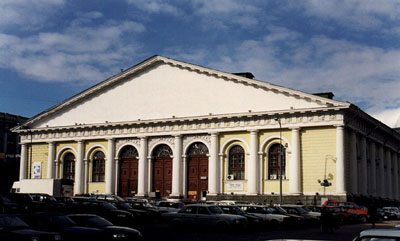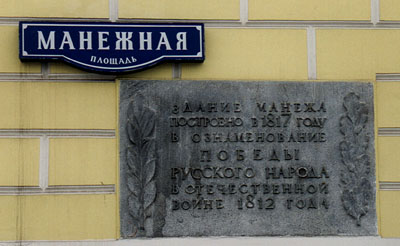MANEGE
In the autumn of 1817 Moscow prepared to celebrate solemnly the fifth anniversary of the victory in the Patriotic war. Special detachment of Guard combined from the heroes of Napoleonic wars ought to arrive from St. Petersburg. There was an order to construct a "exercisehouse" (an arena, on which the infantry regiment, could be developed- it's something about two thousand soldiers) for reviewing and parade of troops. The talented engineer-mechanic, the chief of administrative departement of the communications and public buildings, head of the committee of constructions and hydraulic jobs, engineer - general A. Betancourt.
He has charged the construction of the manege to the general A. L. Carbonier,who has chosen in the zone of ceremonial building of city for erection of a building Mojovaya square (nowadays it's a square of the 50th anniversary of October Revolution[1] The project was approved on June 10, 1817. It was ordered to complete the construction not later then October 1 of this year. Due to extremely limited terms of construction Carbonier began preparatory jobs to the erection of the building in spring of 1817, even not waiting of the official approval of the project. The chief architect of construction Lamoni and actual manufacturer of all jobs, engineer - lieutenant A. Kashperov helped Carbonier in the erection of of manege.
Opened on November 30, 1817 the manege became a miracle of engineering art of that time. The space under it was 7424,67 square meters covered by common roof laying on wooden roof timber, by length of 44,86 meters each, without any intermediate pillow blocks. Such surprisingly courageous decision was applied for the first time in world building practice and has demanded from Betancourt the exact and careful calculations of the construction of ceiling's coverings and their loadings. Besides of the constant maintenance of the initial configuration of roof timbers their wooden beams communicated by rather complex system of metal mechanical tractions regulated by special nuts length. For many years there was a special military crew supervising the preservation of the roof timbers forms and regulating the length of drafts it consist of. And even till now wooden forms were excellently saved and are quite capable to work with same loading.
The building is rectangular and one-storeyed. Its length is 166,42 meters, width - 44,81 meters and height about 15 meters. The majestic appearance of manege is emphasized also by his(its) external decoration. Massive walls, reinforced from bottom based on high rusticated socle. The lateral walls of a building are partitioned evenly by columns from Tuscan order. And between columns in deepened apertures of archs are placed the vaulted windows thats why the walls of the manege seem even higher. The top part of the building is implemented in Doric order. On face walls of the manege under smooth pediment, and also in the middle of lateral walls in high niches, coming through socle, you can see the elongated trippled wooden gates. Thanks to big windows which occupied third of total area of walls, there are plenty day time light inside the building.
Manege is one of the best creation in Moscow, which rebuild after great fire of 1812, an original monument to the heroes of Patriotic war of 1812. Here took place the celebration and parade in the case of the fifth anniversary of the victory of Russian weapon in this war.
Lets transfer mentally to that faraway and memorable day, enter to the manege and take a look at this epic heroes starked in the ranks, which battled under Smolensk, stood up to the fire of the enemy at Borodino, fighted for Maloyaroslavets, smashed the enemy at Krasnoe and at Berezena.There are medals with light-blue ribbons of Order of Andrey Pervosvanny on the soldier's breast with the inscription «1812 year».
In the first rank you can see a tall grenadier of leyb-guards of Izmaylovsky regiment, participant of all big battles in 1812, Ilya Yamnik, awarded for his bravery by Georgievsky cross. His face is weather-beaten,his eyes seriously look under polished high shako, his big brawny hands squeezed strongly a gun 14 feetlong with sharp steel bayonet.
Near him you can see a corporal of leyb-guards of regiment Semenovsky Egor Etgord. The uniform of this brave Latvian is also decorated by soldier's Georgievsky cross. Beside him there are soldiers of the same regiment: Ukraian Ivan Galshenko, his comrade - the native from Kurskaya area Ivan Kondratov and grenadier of the first mouth of the regiment chevalier of the Georgievsky cross Kondraty Ekimenko. There is also a drummer of leyb-guards of the Finnish regiment Vasily Akentiev.
Among the soldiers of the most honourable leyb-guards Preobragensky regiment you can see brave corporal Vasily Lavrentiev, awarded for the battle of Borodino by Georgevsky cross. He is on the whole head above the Guardsmen, which encircled him, each of them is not less than 182 centimeters.
Near them you can see the brave corporal of leyb-guards huntsmen regiment Leonty Shitikov, who was wounded twice in fight of Borodino, and soldier of the same regiment Ivan Vasiliev. N. Muraviev, the participant of the Borodino battle, told about him in his notes:
«During the skirmish at the village of Borodino one young huntsman has come in settlement Gorki to the commander-in-chief with the captured French officer, which he presented to Kutuzov, giving the prisoner's sword to him. There was a complete happiness on the face of young åãåğÿ. The French officer announced that when they occuped the bridge this young brave had rushed forward, grasped his sword, deprived it, and dragged him behind a gate. Kutuzov gave Georgevsky cross the young soldier and new chevalier run again into the battle».
Dochturov, highly estimated feats of Russian soldiers in the Borodino battle, reported to Kutuzov: «The Guards regiments Lithuanian, Ismailovsky and Finnish during the battle have rendered bravery, worthy to Russian soldiers, and were first ones, who with inordinate courage, keeping the enemies aspirations, defeateed him by bayonets. The other Guards regiments Preobragensky and Semenovsky also reflected the enemies fearlessness. In general, all troops have showen this day fiercely bravery».
During the stay of combined detachment of Guards in Moscow the batallions of various regiments studied hard the front preparations on the manege. From Hamovnichevsky barracks which were on Prechistenka (nowadays it's Kropotkinskaya street) the batallion of leyb-guards Semenovsky regiment went to the manege. The active participant of Patriotic war of 1812, well known decembrist Muraviev-Apostolov who served in the Semenovsky regiment that time, receted about the interesting episode which has happened during the occupations on the manege.
During the trainings the batallion commander noticed, that one of the soldiers unsufficiently precisely and quickly takes a hand from a gun on a command «present». The colonel commanded to the soldier to stand before the line and to nake his back for the punishment. Then the younger brother of Matvey Ivanovich - Sergey, also the participant of battles of 1812, future decembrist and chief of revolt of the Chernigovsky regiment, stood up for the soldier. The protest os Sergey Ivanovich, officer and nobleman, in protection of human value of the simple soldier, «of the bottom grade», struck extremely the commander and all officers of the batallion. The trainings have stopped, the soldier was not punished, the officers have surrounded Sergey, discussing what had happened, and Matvey in deep gratitude for courageous manifestation of philantrophy even kissed his brother's hand. Such were real «children of the Twelfth year», «bogatyrs forged from pure steel»...
Due to the fact that the manege had been constructed in much hurry, in one year after opening the roof has given îñàäêó and was corrected by Carbonier. But the proceeding îñåäàíèå of rafters has forced Betancourt in 1819 to propose the offer on serious reorganization of the roof. But it was completed only four years after, in 1823 - 1824, under the project and the direction of the military engineer, colonel Ğ. Ğ. Bayss, with active participation of Kashperov as basic executor of jobs on assembly and installation of the newly made rafters. At this time remarkable architect and town-planner, future founder of the Triumphal arch - O.I. Bovet was involved in works on the ornament of the manege.
Bovet deeply filled and correctly understood the role and importance of the manege as building - monument in the ensemble of ceremonial building of the centre of Moscow. He offered to place on facades ëåïíûå ornaments which ought to glorify the military power of Russia. The elements of decorative furniture of the manege were developed by Bovet in the series of figures and sketches. Together with Kashperov he thought over a practical embodiment(realisation) and offered sculptural decoration and made the special estimate on works over the building's furnishings.
Bovet insisted on the simplicity of the decorations of the face facades, having limited a fine relief under the cornice. The decorative details looking as military attributes Roman legioners, were executed over Bovet's figures, and were placed outside and inside of the manege by summer 1825.
The plaster and raised works were made under the direction of Bovet have emphasized even more the solemn significance of the manege. Skilfully connected with architectural shape of the monumental building the decoration from small strict rhythmic reliefs has given completeness to all structure - it's one of the best products of classisism in Russia.
The Manege building was saved up to now without any special external changes. In the first years of the existence it was used for front trainings, parades and reviewes of the troops. Since 1831 it becomes the cultural centre. The first exhibition of ethnography of the peoples of Russia took place in it,then there were many others: the first international exhibition of automobiles and bicycles, polytechnical, agricultural and industrial exhibitions. Here the pianist Rybenshtein acted his concerts, the orchestra was directed by composer Berlioz, the compositions about military events of 1812 were played, the grandiose national festivals - promenades and fairs were arranged.
The first serious restoration of Manege was made in the 30 years of XX century. By efforts of the skilled Soviet engineers, architects and artists the initial features of a memorable building were revealed and restored and its life was prolonged for many years.
In post-war years the wooden rafters were increased metal one, which saved an external contour of the roof, but that demanded the installation of intermediate support inside them. From the side of the square the threefold entrance gate was replaced by a three-arch entrance, to which granite steps conducted. Behind massive wooden doors the large foyer disappears. In 1957 the Manege became the Central exhibition hall of capital.
For 23 years more then 110 art exhibitions took place in it, it was visited by more than 22 millions of moscovites and visitors of the capital. Today there is the national university of arts and constant lecturer hall in Manege.
About the fact that this building is one of worthy monuments to the simple soldiers of Great Battle, to the simple soldiers of Russian army, whose bravery, endurance, courage and valor stoped the Napoleon's invasion in 1812, is spoken by the avaricious words on a memorial board from the grey stone: «The Manege building was constructed in 1817 in the commemoration of the victory of Russian people in the Patriotic war of 1812».
Translated by Maxim Gontcharov.

